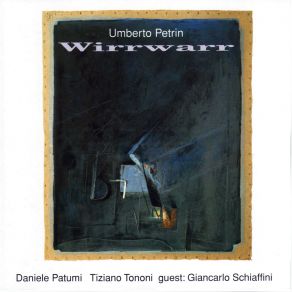Wirrwarr
Download links and information about Wirrwarr by Umberto Petrin Trio Quartet. This album was released in 1996 and it belongs to Jazz genres. It contains 13 tracks with total duration of 01:00:40 minutes.

|
|
|---|---|
| Artist: | Umberto Petrin Trio Quartet |
| Release date: | 1996 |
| Genre: | Jazz |
| Tracks: | 13 |
| Duration: | 01:00:40 |
| Buy it NOW at: | |
| Buy on iTunes $8.99 | |
Tracks
[Edit]| No. | Title | Length |
|---|---|---|
| 1. | Aragon | 5:00 |
| 2. | Inscape | 4:03 |
| 3. | Wirrwarr | 11:18 |
| 4. | Prospettiva 1 | 2:00 |
| 5. | Prospettiva 2 | 0:54 |
| 6. | Prospettiva 3 | 3:00 |
| 7. | Prospettiva 4 | 3:30 |
| 8. | Ogunde | 5:18 |
| 9. | De Kooning's Woman | 4:46 |
| 10. | Le sei di sera | 6:32 |
| 11. | After the Rain | 3:54 |
| 12. | Contiene una linea di lunghezza infinita | 7:54 |
| 13. | Hiatus | 2:31 |
Details
[Edit]Umberto Petrin's Wirrwarr (a title chosen from the work of poet Edoardo Sanguineti) is an explosive, controversial meditation on the relationship of jazz to classical lyricism, 20th century visual art, and poetry. Petrin's construct builds on his earlier album, Ooze, in that it goes after the "jazz modules" that are most often neglected, rather than harmony, interval, rhythm and melody. Petrin and his musicians — Daniele Patumi on bass; Tiziano Tyononi on drums and trombone; Giancarlo Schiaffini on two tracks — move into the kaleidoscope of sound as it emerges timbrally and tonally from the intersection of the trio or quartet. Here the artist digs his melodies out of the detritus of culture and shapes them in physical blocks ("Aragon") for his trio to elaborate on in alternate rhythms and thematic variations. On the "Wirrwarr" suite, elements of swing, funk, carnival music, serialism, and free jazz wrap themselves around constructed phrases that speak almost visually of their intent to explode at any moment. Tension builds between pianist and rhythm section almost from the opening measures and then opens out onto a fertile soundscape of country song and pastoral balladry before beginning its descent into the off minor maelstrom. There is real hyperbole in Petrin's music; he makes long poetic statements in his solos with lines that are angular and harmonically elegant. He accents the middle eights, fours, and sixths that make up harmonic problems and refuses to resolve them, leaving them to hang on the end of a measure without a turnaround. His flatted ninths and skittering skeins of 166th notes challenge the rhythm section to open up the work dynamically, and when they respond he careens off into another direction. This is difficult music that is a sensual pleasure to listen to and a rigorous intellectual exercise to get. But given the deep romantic ideals of its composer, it gets across in the same way a colorful abstract painting would: viscerally.